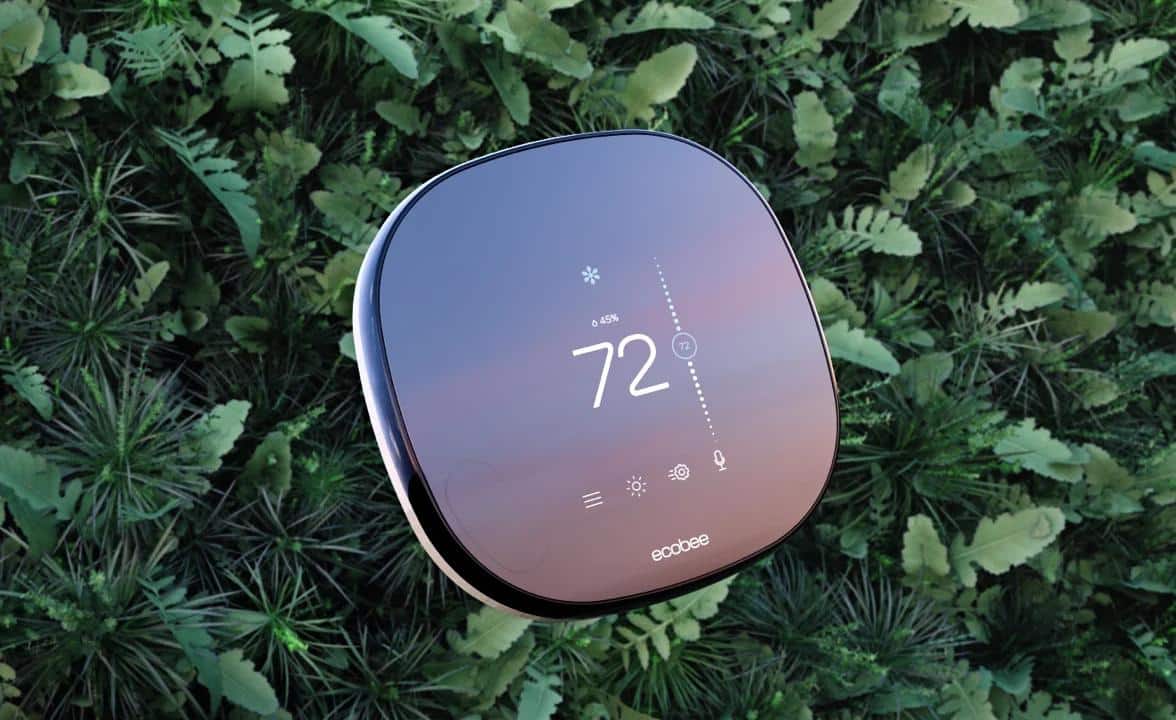

ecobee
ecobee’s line of smart thermostats can help to provide energy savings for a variety of different HVAC systems. Their thermostats provide intelligent automation for your heating and cooling system, allowing you to reduce your energy usage while staying comfortable. Keep reading for a breakdown of the different ecobee smart thermostat options.
How we review smart thermostats
To review smart thermostats, we evaluate each one on the following categories and features:
- Mobile app – Can you control the device with a mobile app, and what kind of functionality does the app give you? Is it compatible with other smart home products?
- Energy savings – How much energy can the thermostat help you save? We look for products and devices that carry the ENERGY STAR seal for the most-efficient products.
- Installation – Is the thermostat meant for DIY installation or does it require professional installation?
- Price – How is the smart thermostat priced compared to other brands, and how does this compare to the amount of money you could save on your energy bill?
- Learning capability – Does the thermostat learn your heating and cooling preferences automatically, or do you have to program them?
- Warranty – Does the brand offer a warranty, and if so how long does the warranty cover your thermostat?
Each product featured here has been independently selected by the writer. If you make a purchase using the links included, we may earn commission
ecobee smart thermostats
ecobee makes a line of small, efficient programmable thermostats meant to maximize energy-efficiency. These smart thermostats feature touch functionality, remote access, and a variety of options that allow for greater control over home heating and cooling. And similar to the Nest Learning Thermostat, Ecobee thermostats can learn your routines to better maximize your energy savings.
ecobee SmartThermostat with voice control

The ecobee SmartThermostat with voice control provides maximum energy efficiency and ease-of-use compared to old thermostats. Voice commands makes it easier to program settings, control schedules, and change temperatures at a moment’s notice all without having to leave your seat. Plus, the advanced eco+ system learns how to best heat and cool your home when energy costs are at their lowest while also reducing the strain on power grids.
Why buy – Being able to create custom schedules is a major selling point for smart thermostats, but being able to control all of those same things through voice functionality is an even bigger benefit. Plus, thanks to its eco+ system the ecobee SmartThermostat with voice control is the EcoWatch pick for best energy-saving smart thermostat.
Price – The ecobee SmartThermostat, technically the ecobee 5 of its line of products, is one of the more costly units on the market, priced at 0.
Warranty – ecobee products come with a three-year limited warranty from the date of purchase. The warranty protects against any defects in workmanship or materials that can occur under normal use. It does not, however, cover damage done through abnormal or excessive use. Details of the warranty will also depend on who you purchase the unit from.
How it works – There are a variety of ways that users can get greater energy-efficiency and savings. Users can program through the touch screen on the unit itself at any time. There is also a smart phone app that allows for programming and control remotely. Finally, the voice functionality provides programming without either of those things. Users can simply voice their commands to change temperature, set a schedule and more. It also includes an ecobee SmartSensor with occupancy detection to help control your energy use.
Mobile app – ecobee offers an app for controlling their smart thermostats. Users are able to gain all of the control and functionality that they normally would through the touch screen panel with the convenience of being able to make changes remotely. It is a higher level of control and convenience than ever before. While the thermostat comes with Amazon Alexa built in, it is also compatible with Apple HomeKit, Google Assistant, IFTTT, and Samsung SmartThings.
Energy savings – The Ecobee SmartThermostat with voice control is ENERGY STAR certified. That means it has been tested for optimal energy efficiency. ENERGY STAR ratings indicate that said product can offer additional energy savings than others on the market. Users can expect to save 23% annually on their energy bills by using the Ecobee SmartThermostat with voice control. This can vary slightly depending on the age of the current HVAC system as well as the size of the home.
Installation – Installation can either be performed by a third-party retailer or done in a do-it-yourself project. Those attempting a DIY installation will find an installation guide accompany the thermostat. Standard installation will generally take about 45 minutes, though that can vary depending on the experience and general handiness of the person involved.
Certified refurbished ecobee4

Depending on budgets, going with a brand-new smart thermostat may not necessarily be an option. That is why having access to a refurbished smart thermostat can be a viable option. Plus, choosing a refurbished model is sustainable choice that saves e-waste and saves you money. Note, you may be able to find new ecobee4 models through third-party retailers.
Why buy – Each refurbished ecobee4 provides top-of-the-line smart thermostat functionality without paying the premium that comes with a brand new unit. Built-in Alexa functionality means you have voice control of your thermostat with your Amazon Echo or smart home for complete smart home functionality.
Price – The $185-$200 price tag, combined with the “refurbished” tag, may sound scary. But there are a lot of functions, features, and things included that could make this a potentially great buy for those hoping to find a quality smart thermostat while reducing waste and cost. If you do find a new model through a third-party retailer, you will pay more than for a refurbished model.
Warranty – When purchased directly through ecobee, the ecobee4 comes with a limited three-year warranty. Like other ecobee devices, that includes protection against manufacturer defects as well as issues that occur through regular use. As is the case with other warranties, it will not cover irregular or improper use, so check the details on the warranty before use.
How it works – The ecobee 4 includes a ton of smart features. Programmable schedules for heating and cooling, touch-screen and app functionality, and a smart-learning function that adapts to your heating and cooling needs. Even better, it comes built-in with Alexa for voice control functionality and compatibility with Amazon Alexa smart home units. Every refurbished thermostat undergoes a rigorous recertification process and must pass the same quality assurance tests that a brand new thermostat does.
Mobile app – ecobee offers a smart device app for ios and Android devices that gives you greater accessibility and control. In addition to Alexa and touch-screen functionality, the smart phone app allows for remote access at any time so long as it is a device on the same Wi-Fi network. That means convenient use whenever, wherever the user desires.
Energy savings – The ecobee4, even when refurbished, is ENERGY STAR certified. Users have experienced a whopping 23% energy savings on their heating and cooling bill through the use of the ecobee4, making this brand one of the best for smarter energy use at home.
Installation – As is the case with other ecobee smart thermostat models, you have the option for professional installation as well as do-it-yourself installation. There is an accompanying quick installation guide, allowing for proper installation within 45 minutes depending on the experience level of the user.
ecobee3 lite

The ecobee3 lite brings a lot of the same features and functionality that the ecobee4 offers at a slightly more cost-effective price. When looking for advanced temperature control, voice functionality, and energy savings, the ecobee3 lite has you covered. This model does not include any SmartSensor occupancy sensors.
Why buy – The large, easy-to-use display, smart phone app functionality, and even Alexa voice control mean that users can control their heating and cooling from anywhere. Plus, ecobee’s advanced eco+ system allows the 3rd gen system to heat and cool your home when energy prices are lowest and when it will cause the least amount of strain on electric grids.
Price – At $170, it is slightly less expensive than even a refurbished ecobee4, as well as some of Google Nest and Honeywell’s smart thermostat options. With professional installation, expect all costs to be about $200, though it can vary based on the installer.
Warranty – The ecobee3 lite is covered by a three-year limited warranty from ecobee. During that period, it covers the device from manufacturer defects and workmanship under regular service and normal use. Any improper use or lack of maintenance can void the warranty, so be aware before using.
How it works – Users have a multitude of ways to use the ecobee3 lite to save on their energy costs. Working with most modern HVAC systems, the ecobee3 lite works to limit the amount of energy used when heating and cooling the home through its eco+ system. This means it will use energy when costs are cheapest and will avoid using energy when demand is high to prevent extra strain on grids. It also includes an AC Overcool feature that can use your air conditioner to help lower the humidity in your home if you don’t have a dehumidifier.
Mobile app – ecobee’s smart phone app lets users program settings, create schedules, and even adjust current temperatures in real time. Remote functionality means that users do not need to be within range of voice control nor do they have to use the control panel to implement heating and cooling changes.
Installation – Though there are professional installers who can do the job, the ecobee3 lite comes with a quick install guide. Depending on the experience and general handiness of the person involved, it can take anywhere from 30-45 minutes from beginning to end.
Additional ecobee smart home products
ecobee smart thermostat products are designed to work with the ecobee SmartSensor. These remote sensors works to detect temperatures in individual rooms, like your living room or bedroom, helping to eliminate pockets of air that are too warm or cold. These room sensors can help make your system even more energy efficient.
ecobee thermostat energy rebates
Your local energy provider may offer rebates for using energy efficient smart thermostats. Check with them to see if there are rebates offered that may cover some or all of the costs of an ecobee smart thermostat.
ecobee smart thermostat FAQs
What is ecobee eco+?
The ecobee eco+ software takes their smart thermostats to a new level beyond just geofencing. It can actually detect when you have left your home, adjusting the settings to limit energy usage when you are not around. When you come back, it restores your comfort settings to the pre-set schedule and even learns your routine and preferences to keep you comfortable automatically. It also helps reduce strains on the electric grid in your area by using energy when it is cheaper to heat and cool your home. ecobee smart thermostats can save around 23% on energy usage with the eco+ capable of saving even more thanks to this unique function.
Do ecobee thermostats come with Alexa?
Depending on the type of ecobee smart thermostat that you purchase, it may or may not come with Alexa functionality built-in. Alexa-compatible units allow for pairing with Amazon Echo smart home devices for voice control functionality. That means users can set programming and schedules through the console, app, or voice function.
Ryan Womeldorf is a freelance writer who covers technology and consumer goods, including smart home tech. He is a husband and father of two (five if you count his pups).

 233k
233k  41k
41k  Subscribe
Subscribe 